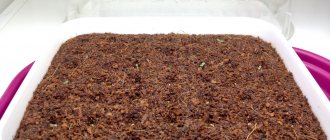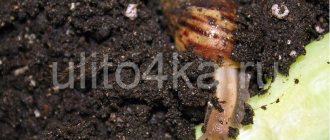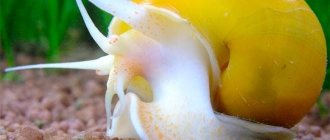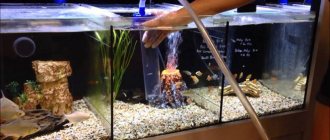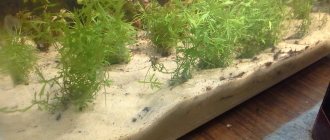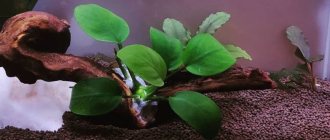Every snail owner should know that the health of his pets directly depends on their living conditions and nutrition. Snails need, first of all, a terrarium with sufficient volume and filler. The filler in the terrarium plays a key role, since when used, the conditions for keeping the mollusks are closer to natural. Today we will take a closer look at one of the most popular fillers. This is coconut substrate for snails. We will tell you how to use and process it correctly, how much you need to put, what types there are and the main advantages of such soil.
Sand
Breeders have different opinions regarding sand as a filler for a terrarium. Sand is the natural habitat of Achatina, some say. Snails feel comfortable in the sand; such an environment stimulates Achatina to reproduce and lay eggs. Others believe that it is not advisable to keep a snail on sand, since sand does not retain water well, scratches the body and shell of the mollusk, and also scratches and stains the glass walls of the terrarium. The snail shell gets scratched by sand, becomes dull and white, and it is not possible to restore its original appearance.
Creating comfortable conditions
Achatina snails will feel comfortable both in a small glass aquarium and in a special plastic container with ventilation holes. In any case, you will need a heavy top cover that will not allow the snail to escape. The lid must have holes for fresh air.
It should be taken into account that snails climb the walls of the terrarium well , so the holes should not be too large. Otherwise, there is a high probability that the snail will simply run away and it will be very difficult to find it.
It is not advisable to cover the terrarium with bark or sawdust, as the snails can be severely scratched. Mollusks feed on all kinds of waste in the form of cabbage leaves or lettuce.
Types of Coconut Substrate
Coconut coir is nothing more than the inner fibrous part of the coconut. Typically, the substrate is sold in the form of pressed briquettes. Raw materials differ in the degree of particle fraction, thus, there are the following types of coconut substrate:
Read also: How to make a soft eraser from a hard one
- Coconut chips are large pieces of coconut. This type of raw material is the least preferable for shellfish, as it does not retain moisture well, and large, prickly pieces can damage a delicate pet.
- Coconut fiber - are thin, long and strong threads. They retain moisture better, but can be dangerous for young snails, as the animal can become entangled in it and suffocate.
- Coconut peat is the finest fraction, a fine crumbly powder that holds moisture better than the previous two and is the safest choice for snails.
Leaf litter
Leaf litter is practically not used as an independent filler for snails, since dry leaves cannot retain moisture. As a rule, litter is used as an addition to the main soil or mixed with moss. Dry leaves make the soil looser and more convenient for hiding in the substrate. These mollusks like to crawl on dry leaves and even eat them. Therefore, preference should be given to the following types of trees under which to collect litter: oak, birch, maple, beech, aspen, rowan. But poplar and chestnut leaves are not recommended. The most popular among breeders is oak litter for snails, since this type of dry leaves is the least susceptible to rotting. But you shouldn’t throw away all the rotten leaves from the terrarium - your pets will happily feast on them, since in nature it is food for them.
You can buy such a filler for a terrarium or make it yourself.
Preparing leaf litter for snails is quite simple. It is necessary to collect fallen or fresh leaves, rinse well, pour over boiling water, and dry. Dry litter should be stored in a fabric bag in a dry place.
Microclimate
The health and well-being of snails directly depends on the microclimate. A comfortable life for snails is possible at a humidity level of no lower than 60% and no higher than 90% .
At the same time, humidity is a parameter that concerns not only the air, but also the soil, which actively releases moisture. You can adjust the microclimate using a simple spray bottle. You can irrigate with warm water not only the substrate, but also the walls of the terrarium. Snails are happy to collect drops of moisture from the surface of the glass.
You need to monitor the humidity and temperature inside using a thermometer and hygrometer . In almost any pet store, you can purchase both mechanical and electronic options. The optimal choice is a 2 in 1 universal device. An electronic thermometer-hygrometer, easily attached to the wall of the terrarium using a suction cup.
Under natural conditions, during the daytime, mollusks prefer to hide in the shade. They become active in search of food after sunset. Therefore, when kept in artificial conditions, it is strictly contraindicated for snails to be exposed to direct sunlight. Under no circumstances should you place a plastic or glass terrarium on a windowsill. Although they are heat-loving animals, dry heat can kill them
You should not install additional lighting fixtures in or near the terrarium. An ordinary room one will be enough.
Other fillers
The best option is to mix the soil with peat and sand. Each breeder must select the proportions individually, with such a condition that the snail can freely burrow into the ground and breathe. The prepared soil should retain moisture well and allow air to pass through.
Keeping snails on newspapers, paper and napkins is not allowed. In some cases, snails are placed on clean white paper for a while to remove parasites or if the shell is damaged. Some species of obligate woodies can be kept on wet wipes without burrowing into the ground or falling off the terrarium lid.
Observe the snail to determine optimal humidity and soil conditions. If the snail spends almost all the time on the lid or wall of the terrarium, then the humidity is high or the soil does not like it. If it is closed in the sink, then the humidity is low. If the humidity and soil are suitable, the snail is active at night and burrows into the soil during the day.
Each snail owner decides for himself which soil to choose for snails. We tried to objectively talk about each of the types, describe their main advantages and disadvantages. We hope that our article was useful to you, and you will select the appropriate filler for your snail.
4.2 / 5 ( 10 votes)
Substrate types
You can choose different soil for snails of this type. It all depends on the owner’s preferences and financial capabilities. Let's present the most popular and reliable options. Often Achatina owners prefer to use coconut meal. It is also convenient because it is easy to wash and dry, so it is suitable for repeated use. This substrate is sold both in finished form and in briquettes. If the choice is made in favor of the second option, you need to prepare the meal yourself. To do this, the briquette is filled with hot water, cooled, washed through gauze, and then thoroughly dried.
Soil mixtures for flowers
On snail breeding websites there are often reports about keeping snails on soil for flowers. The most popular soils are for begonias, orchids and violets.
Please note that any flower soil is not suitable as a filler for a snail's terrarium!
The mollusk crawls along the ground and passes it through itself in the process of eating. The soil for plants and flowers, regardless of the type, always has a low pH and contains fertilizers, which are poisonous for these pets. Gradually, toxic substances from fertilizers will accumulate and after some time the mollusk will die from poisoning.
If you decide to give the snails flower soil, then first rinse it under clean, settled or filtered water to get rid of fertilizers, and add a small amount of dolomite flour or feed chalk to neutralize the acid-base environment (the proportions are approximately the same as for peat) .
What is coconut substrate
Coconut substrate is the processed inner skin and shell of a coconut. This product is popular among flower growers. If diluted, it can be used for growing flowers and seedlings. It is also used as a filler for terrariums. This product has been in use since early 2007.
Benefits of Coconut Soil
This type of substrate has many advantages:
- Organic and natural ingredients are used in the production process.
- Excellent moisture retention. If the material begins to dry out, it becomes light in color.
- It does not clump, the snails will not suffocate. They love to bury themselves.
- All existing pathogenic microorganisms die.
- The product is neutral, which is very important when caring for snails.
- If it is thoroughly washed and protected, it can be used several more times.
This type of soil has many advantages
Some snail owners have noticed that the mollusks climb the walls of the terrarium after they were transplanted onto coconut shavings. It's quite normal. The substrate has a certain salt content. Therefore, the purchased product should be thoroughly rinsed under running water.
How to prepare coconut substrate
It is important to know how to prepare coconut substrate for snails. The first thing to do is soak the briquette. To do this, place it in a deep pool or bucket. The choice of container depends on how many liters of substrate you need. Pour boiling water over everything. The substrate must be completely covered with water. Leave to cool at room temperature. Please note that the coconut will expand in volume when it comes into contact with water. If the briquette volume is 2 liters, pour in about 1-1.5 liters of water.
The first thing to do is soak the briquette.
It says on the package how much it will cost. If the briquette is large enough, some of it will be used. The product is quite durable. It is difficult to cut. It is recommended to make cuts along the string. Then use an ax to separate the desired part.
The product is quite tough.
Once it has cooled, transfer it to a sieve or cheesecloth. Rinse under running water. Rinse until the water runs clear. If there is an unpleasant odor, rinse again.
Production
Coconut substrate is a product of processing the inner part of the peel and shell of a coconut. This product is used primarily in plant growing, as soil for growing plants, and as a filler in terrariums for exotic pets. Coconut soil began to be used in snail farming relatively recently, around 2007. The largest production facilities are located in Sri Lanka, India, Indonesia, the Philippines, and Mexico.
The production process is carried out in several stages:
- Preliminary soaking and washing of the coconut peel, as a result of which partial fermentation occurs, and the raw material becomes porous, and the concentration of salts is reduced;
- Straightening using special devices, beating until softened;
- Hand combing using special combs;
- Sorting into fractions;
- Washing and drying to the required humidity;
- Mixing fractions depending on purpose, pressing.
The quality of the finished substrate will depend on how thoroughly the processing was carried out.
Application
Coco soil is a multifunctional material. Below are the most common uses:
- instead of soil;
- as an additive to create optimal moisture capacity;
- for growing seedlings;
- for rooting cuttings;
- for filling high beds;
- for vertical gardening;
- for mulching plants;
- for storing roots and tubers (dry);
- as soil for terrariums.
For flowers
For moisture-loving indoor flowers, you can use coco soil without other additives or as one of the elements of a composite soil. Coconut fiber for seedlings increases soil breathability, accumulates moisture and nutrients from nutrient solutions and mineral fertilizers. In order for the material to exhibit its beneficial properties, its share must be at least 30%. Peat tablets, which can be soaked directly inside the seedling pots, are optimal for growing seedlings. It is better to use mats in greenhouses.
Coconut peat is used not only in indoor floriculture, but also for open ground plants. When the substance is added to heavy soil, the acidity decreases, the soil becomes more crumbly and unattractive to pests. When creating raised beds, it is useful to use coconut husks as the bottom layer. Recently a new product has appeared on the market - thin layers for mulching. They are produced in the form of rolls or circles of different sizes. This mulch protects the plant from overheating or hypothermia, and also from drying out, allowing you to reduce the frequency of watering.
For snails
Not only flower growers and gardeners liked coconut flakes. Owners of home terrariums – fans of breeding giant snails – also became interested in this product. Achatina's skin is delicate and soft; the soil should not injure it. Moist coco peat works great. You need to make sure that the soil does not dry out, otherwise the snail will be forced to moisten it with its own mucus. This is not beneficial for the mollusk and does not look aesthetically pleasing. Coconut soil, capable of retaining large amounts of moisture, is very popular with Achatina owners.
Snails breathe through their skin, so good soil permeability is very important. Coco soil absorbs odors, does not rot, and prevents the proliferation of microorganisms and mold. Snails happily burrow into the material and feel great there. The thickness of the required layer depends on the size of the snail. The substrate should be changed as it gets dirty. After washing and boiling, the soil can be reused.
Kinds
You can buy coconut substrate for snails in the following types, depending on the fractions:
- Coconut chips are large pieces of the shell of this nut that have low moisture holding capacity. It is preferable to use them for growing orchids or for keeping reptiles, but it is better not to use coconut chips for snails, since it is difficult to burrow into such soil, and large pieces will cause inconvenience to mollusks.
- Coconut fiber - has the form of thin and strong long threads. It retains moisture well, but can be dangerous for keeping shellfish, as young specimens can become entangled and suffocate. We would not recommend using coconut fiber for snails.
- Coconut shavings or peat - has the finest fraction and has the highest moisture capacity of all three types. The most suitable option for snails.
Coconut substrate can be purchased at flower or pet stores. The substrate is sold in dry pressed form or ready-to-use, loose and wet.
But you should only buy coconut soil for snails in pet stores, since the substrate for plants may not be processed so carefully, and besides, it may contain substances harmful to mollusks. But this does not mean that the substrate purchased at the pet store does not need to be processed. They can supply any raw material, and the manufacturer will package and sell it, without knowing about the level of processing. Therefore, any substrate must be very carefully prepared before placing it in the terrarium. We will describe below how to prepare coconut substrate for snails, but first we will highlight the advantages and disadvantages of this soil.
Advantages and disadvantages
Let's highlight the main advantages of using coconut substrate in molluscaria:
- Environmentally friendly, safe product;
- High moisture capacity, thereby maintaining the necessary microclimate;
- Very loose and soft, does not form lumps;
- Does not lose properties after complete drying;
- Does not contain parasites or other harmful parasites;
- Close to neutral pH;
- Convenient for keeping snails, it is easy to handle;
- Can be used several times after treatment;
- Low cost.
What shortcomings can be noted?
- Snails can consume soil in search of nutrients. From a large amount of coconut soil consumed, the mollusk's intestines become clogged and the snail dies. But, as a rule, naturalists consume the soil. Pets are accustomed to receiving nutrients from the food and supplements offered and do not perceive the substrate as their source.
- If not properly processed, it may contain a high concentration of potassium and sodium salts, as well as chlorine in bound form. Moreover, this does not depend on the manufacturer, so you will need correct and careful processing.
How to prepare coconut substrate
As mentioned above, an average of 7 liters of soil comes out of one briquette. Therefore, many snail breeders use part of the briquette rather than all of it.
- Cut 1/4 of the briquette, place in a container with hot water for 20-30 minutes.
- Then the soil is placed in a colander and washed several times with running water.
- Lightly wring out and place on the bottom of the container.
The hotter the water, the faster the coconut fibers swell. The soil should be moist, but not wet.
Where to place
These pets are not very picky about environmental conditions, but the minimum parameters must still be observed. Otherwise, the individuals will feel uncomfortable and will most likely die. They like quiet places, protected from pets and sunlight. It is advisable to place it in rooms with high humidity and sufficient temperature. The box must contain a substrate for the substrate.
Adults prefer a deep base - at least 7 centimeters. It is best to use ready-made soil options, which are sold in gardening stores; such soil does not contain harmful impurities. You need to check in advance such an important parameter of the substrate as pH (it will be written on the packaging). A pH level of 7.0 will be sufficient; lower values will negatively affect the condition of sensitive skin and sinks.
Soil replacement
The terrarium substrate must be replaced from time to time. It should be replaced or treated as needed when the substrate becomes dirty. The procedure should be carried out at least once every 3 weeks. Sometimes flies, nematodes and unpleasant odors appear. In this case, the substrate should be replaced immediately. Hygiene procedures are carried out daily.
Periodically replace the soil in the terrarium
In terrariums with adult snails, the substrate can only be replaced or treated. When eggs appear, work should be temporarily stopped. If the temperature changes, all offspring will die.
How often to change coconut soil
Dry snails are very easy to care for. However, they must be kept clean. It is advisable to remove food debris and excrement from the bottom daily. They will decompose. Once a week, a small amount of new substrate is added to the terrarium. Pre-treatment of bottom soil.
Add a small amount of new substrate to the terrarium once a week.
Snail keepers remember that many types of mollusks react poorly to a new substrate. Especially if you are changing the entire substrate at once. Therefore, every few weeks, remove the old substrate and scald it with boiling water. Then put it back in. Add new soil. Do this carefully. In small portions.
How often should it be changed?
Of course, the coconut substrate needs to be changed periodically in the terrarium, and the container itself must be washed well.
In order to determine the need to replace the soil, you need to look at it carefully and assess the degree of contamination.
Experts say that for a snail to live comfortably in a terrarium filled with this filler, the soil must be replaced at least once every 3 weeks. After the terrarium is washed and dried, new prepared soil can be poured into it.
Algorithm for preparing the substrate as soil for snails
The substrate can be prepared in different ways. I will give my version of soil preparation:
- We cut the briquette into 3 parts. For a 15-liter container, 1/3 of a briquette will be enough for one snail.
- Place the pressed piece in a bucket or basin. Do not choose containers that are too small, as the soil will swell greatly and increase in size several times.
- Boil water - a kettle or pan. For the specified amount of soil you need approximately 4 liters of boiling water. Pour boiling water over our substrate.
- Mix the raw material well with water and leave until it cools - about 30-40 minutes. During this time, the fiber is well disinfected.
- After cooling, drain the water, leaving the substrate in the bucket. Pour boiling water over again and leave again for half an hour. If the substrate is of high quality, such treatment will be sufficient. If after double processing the fiber is still dirty, there is sand at the bottom of the bucket and the water is dark red, you can rinse it again with regular warm water.
- Now we take part of the substrate in our palms, squeeze it thoroughly so that no water flows from it, but we don’t need it to be completely dry. Place the squeezed-out substrate on the bottom of the terrarium. Our soil is ready.
Advice - to ensure that the dirt settles at the bottom of the bucket and does not fall into the terrarium, before squeezing out the soil, stir it together with the water in the bucket in a circular motion (with a funnel).
Place the substrate in a bucket
Heavy particles - sand, soil, fine dust from the soil, small stones, calcium and food residues (if you reuse the soil) will collect at the bottom of the container (remember what happens if you stir tea leaves). Now you can slowly take the soil and squeeze it out, periodically stirring the soil with water again. Thus, we throw away all the sediment at the bottom and it does not end up in the terrarium.
I poured boiling water over it - the substrate swelled greatly
Some snail owners prefer to boil coconut fiber for 30-60 minutes to prevent nematodes from breeding in the soil. This method is recommended if there is doubt about the quality of the soil. You can also calcine the substrate in the oven at 200 degrees for 15-20 minutes after spinning.
Clean and wrung out substrate in the terrarium
We move the pet into a clean house
One such “refueling” is enough for 3 months. Every month I do a general cleaning, again steaming the soil with boiling water. But when re-rinsing, one fill and rinse is enough. After 3 months there is much less soil left and it is not as fresh anymore, so I throw it away completely and use the next piece of substrate.
Neutralized peat
This type of filler can be purchased at flower shops. Its advantages are good absorption and moisture retention. But peat makes the terrarium dirty and if there is too much moisture, it begins to become waterlogged. When purchasing, pay attention to the pH of the peat; it should be at least 7, since a low acid-base environment can cause burns on the body of mollusks.
If you decide to use peat collected in the forest or purchased in a store without a note about pH on the label, then pre-treat it. To do this, place the soil in the oven or microwave and heat it for about 15-20 minutes. This will get rid of parasites and various harmful organisms. And to neutralize the environment of your filler, mix 3 tablespoons of feed chalk or dolomite flour per 1 kg of peat.
Overview of species
Considering the fact that coconut substrate is quite popular as a type of soil for a terrarium with snails, the manufacturer tried and produced several options. Let's look at what types of it exist.
Chips
This type of soil is not very suitable for gastropods.
The substrate is quite large, it does not retain moisture well, and the gastropod can be injured when moving on it.
The size of a coconut chip can be 1–1.5 centimeters.
Fiber
It is characterized by excellent moisture resistance. There is an opinion that this type of coconut substrate is suitable only for adults. Young animals, due to inexperience, bury themselves in coconut fiber and often suffocate.
This fraction of coconut soil is considered the finest. The filler is presented in the form of a fine, crumbly powder, which is an ideal option for arranging an aquarium for a gastropod , as it retains moisture well and is harmless.
Coconut flakes are sold in briquettes, which are very sealed and specially made. The weight of a briquette can range from 0.5 to 5 kilograms. Only crumbs are poured into briquettes, without any filler.
It is possible to find this filler on sale in the form of tablets, which are characterized by the presence of a mesh shell.
It is very important to buy this soil only in specialized pharmacies or at a pet store. Do not buy coconut filler for snails, which is intended for use by summer residents in the process of planting flowers.
